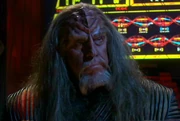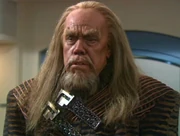The Klingon augment virus was a modified form of Levodian flu that threatened to wipe out the Klingon race in the mid-22nd century. It was inadvertently created by Klingon researchers who were attempting to bio-engineer enhanced warriors using DNA from genetically-modified human embryos left over from Earth's Eugenics Wars.
History

Dissolving cranial ridges
In 2154, Klingon scientists working under the direction of Antaak recovered some augment DNA from a destroyed Bird of Prey that had earlier been hijacked by Human augments created by Arik Soong. Fearful that Humans would create augments and overwhelm the Empire, the scientists attempted to create their own augments to counter the perceived threat.
The effort failed dreadfully. The augments created did develop enhanced strength and intelligence, but they also began to show Human characteristics, from the blatant to the subtle. These included personality alterations and loss of the characteristic forehead ridges. Ultimately, the subjects died agonizing deaths when the incompatible DNA resulted in neural system breakdown. While working to stabilize the process of augmentation, the scientific team augmented a test subject who was, unknown to the team, also infected with Levodian flu. The flu virus in some manner incorporated the augment DNA, turning a carefully controlled experiment into an epidemic. In as much as the unstable augmentation process always killed the subject, this epidemic threatened the Klingon race with extinction.

Antaak before

Antaak after
The Klingons attempted to capture Arik Soong to help them develop a cure, but their efforts were thwarted by Soong's high security detention. The Klingons next arranged to kidnap Doctor Phlox using Rigelian intermediaries and with the assistance of Section 31 agents. Phlox was forced to work with Antaak to stabilize the augment virus. Antaak's goal was to create a stable method of creating Klingon augments, while Phlox's goal was to cure the plague before the Klingons died as a species. Ultimately, the goal achieved lay somewhere in the middle: a method was created that stabilized the process in the early stages – after the cranial ridges dissolved and some minor neural re-ordering had occurred (which caused personality changes), but before the fatal neural pathway breakdown. Because afflicted Klingons' DNA had been altered by the virus, these traits were passed onto their descendants. (ENT: "Affliction", "Divergence")
Evidently, the Excalbians only knew of affected Klingons, as they depicted Kahless himself as affected. This may, however, have been attributed to reading the minds of humans who, at that point in history, only had dealings with Klingon augments. (TOS: "The Savage Curtain")
It would be over a century before they discovered a method of restoring all Klingons to their proper appearance. It is unknown if all the damage done has been reversed, evidenced by the change in color to Klingon blood. (Star Trek: The Motion Picture, Star Trek VI: The Undiscovered Country, Star Trek: The Next Generation)
The Klingons were apparently so embarrassed by the fallout from their failed attempt at genetic enhancement that they refused to discuss the incident with outsiders. Due to the secrecy of the Klingon Empire, knowledge of the change became lost over time to the general population of the Federation. By the 24th century, the reason for Klingons having smooth foreheads was not widely known outside the Empire, and questions were generally met with a brusque answer along the lines of "we don't discuss it with outsiders". (DS9: "Trials and Tribble-ations")
Background Information
This storyline, seen in the Enterprise episodes "Affliction" and "Divergence", was intended in part to explain why Original Series Klingons had a more human-like appearance, and later Klingons did not. The writers also hoped the two-parter would shed some light on the change in the Klingons' temperament and disposition between the TOS and TNG eras.
For years, unofficial explanations had appeared in Star Trek literature to explain the difference between the Klingons from the 1960s series and those in later productions. The idea of genetic engineering was explored heavily in several publications licensed by Paramount Pictures, among them the Roleplaying Game published by FASA, several Pocket Books novels (such as "Rules of Engagement"), and the reference book "The Worlds of the Federation" by author Shane Johnson. These works indicated that the "Klingons" encountered during the Original Series era were "Klingon-Human fusions" intentionally created to make infilitration into Federation space easier. The true nature of Klingons was revealed during the emergency transmission of the IKS Amar as depicted in Star Trek: The Motion Picture.
In addition to the "fusion" explanation, the producers of Star Trek: Enterprise had heard many pitches over the years for stories aimed at explaining the change in the Klingon appearance. Additional theories included that the Klingons seen during the Original Series were from another race than those of later eras and also that some sort of disease was to blame. The Enterprise writing staff mirrored the fan community in that some felt it might be fun to account for the change, while others thought it was probably best to ignore the entire situation. The topic came up again when writer Manny Coto was named showrunner during the series' fourth season.
At first, the producers were only interested in a story with one or more "ridgeless" Klingons who had infiltrated Starfleet for the purpose of intelligence gathering. It was thought the story might involve a surgically-altered Klingon operative aboard the Enterprise, someone like Arne Darvin a century later. Around this time, the writing staff had recently concluded the three-part Augment Crisis arc, and it occurred to them that some of the genetically-engineered embryos might have survived the destruction of the Bird of Prey, and that the Klingons might use these embryos to bio-engineer their own version of "Klingon supermen". This seemed to be a way into a story dealing with the origin of human-like Klingons. More to the point, the Enterprise producers thought it was simply "too cool" an idea to reveal that Kor, Kang and other Original Series Klingons may have had the DNA of Khan inside them.
While some fans clamored for an explanation for the "smooth forehead" Klingons, "Affliction" teleplay writer Mike Sussman hoped to do more – account for the apparent change in Klingon culture between the 23rd and 24th centuries. As depicted in the first Star Trek series, Klingons were notoriously savage, crafty and at times even cowardly, putting this characterization at odds with the more noble and honorable Klingons seen in The Next Generation. The "minor neural re-ordering" noted by Phlox was intended to suggest that the augmented Klingons were not only "cursed" with a more human appearance, but that they also inherited many human weaknesses as well. In "Divergence", the female Laneth, newly infected by the Augment virus, claimed that she "felt fear for the first time since I was a child." Her fellow augmented warriors had "become like (humans)... weak, cowardly."
The Enterprise writers' explanation for the change in the Klingons did not – and could not – satisfy every Star Trek fan. Gene Roddenberry himself reportedly believed any "explanation" was unnecessary; the makeup seen in the films and the later series would have been too expensive during the 1960s. Roddenberry felt it was best to simply imagine that Klingons always had ridges (although this preference was perhaps tossed out the window when the change was noted by the DS9 crew in "Trials and Tribble-ations"). Still, the Enterprise writers felt that the "dramatic convention" explanation was and is still valid, if a viewer prefers it. If one accepts Roddenberry's suggestion that TOS-era Klingons always had ridges – and that the DS9 reference was merely a joke by the episode writers – then perhaps the Augment virus had no lasting effect on the Empire: the disease may have been cured relatively quickly following the events seen in the Enterprise two-parter. After all, there was no reference to it in the "later" series (which of course were produced years before Star Trek: Enterprise).
Apocrypha
In "Against Their Nature", the first installment of the IDW Comics "Klingons: Blood Will Tell" series, it is suggested that, while Phlox's cure removed Augment strength and Augment intelligence, those affected did retain Augment ambition, and as such they were largely responsible for the expansion of the Klingon Empire between Enterprise and TOS, and were able to take control of the High Council.
External links
- Klingon Discrepancy Theories: Where Did the Ridges Go?, a Startrek.com documentary from 22 July 2003.
- Retrovirus at Wikipedia
- Horizontal gene transfer at Wikipedia
